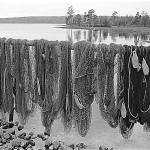

Home
Area
Vätsäri
Övre Pasvik
Pasvik Zapovednik
Nature
Geology
Climate
Water system
Flora
Fauna
Culture
Population
Religion
Sources of livelihood
Old ways of life
Time of industrialism
History
Stone Age
Early Metal Age
Late Metal Age
Middle Ages
Towards modern times
Timeline
Cooperation
Nature monitoring
Nature tourism
Publications
Contacts
Visit Pasvik-Inari
Guidelines
Regulations
News
Links
Sources of livelihood
Hunting, fishing and gathering were the only means to survive during prehistoric times in harsh conditions. The life of hunter-gatherers followed a rhythmic, annual cycle. They followed the regular events of nature and moved after the game and good fishing places. Cultural features of these small societies have been impacted by the most dominant source of livelihood. From at least the early Metal Age onwards, the organisation of societies gradually changed to the siidas (Sámi village or Sámi community). Change was mainly influenced by the development of reindeer herding and State administration. The members of siida shared means of livelihood and common land, and siidas had clearly defined borders which judicial systems of states also recognised. The siidas faded away by the end of the 1800s, or by the early 1900s, because of the gradual establishment of state borders and state legislation.
